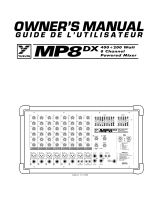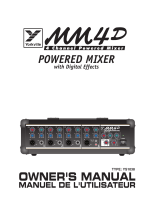STEREO DIGITAL EFFECTS
YORKVILLE SOUND • DIGITAL EFFECTS BY A.R.T.
2 5 5 P R E S E T 1 6 B i t D I G I T A L E F F E C T S P R O C E S S O R
1 0.5s Bright Small Room + 50ms doubling delay
2 0.5s Warm Small Room + 40ms doubling delay
3 0.5s Dark Small Room + 40ms doubling delay
4 0.8s Bright Small Room + 60ms doubling delay
5 0.8s Warm Small Room + 50ms doubling delay
6 1.0s Bright Small Room + 70ms slap delay
7 1.0s Warm Small Room + 50ms doubling delay
8 1.2s Bright Medium Room + 50ms doubling delay
9 1.2s Warm Medium Room + 50ms doubling delay
10 1.5s Bright Medium Room + 80ms slap delay
11 1.5s Warm Medium Room + 60ms doubling delay
12 1.5s Dark Medium Room + 70ms slap delay
13 2.0s Bright Large Room + 80ms slap delay
14 2.0s Warm Large Room + 60ms doubling delay
15 2.5s Bright Large Room + 100ms slap delay
16 2.5s Warm Large Room + 80ms slap delay
B ROOMS & THICKENING
DELAYS
1 1.5s Dark Medium Hall + 50ms doubling delay
2 1.5s Warm Medium Hall + 70ms slap delay
3 1.5s Bright Medium Hall + 90ms slap delay
4 2.0s Dark Medium Hall + 90ms slap delay
5 2.0s Warm Medium Hall + 70ms slap delay
6 2.0s Bright Medium Hall + 50ms doubling delay
7 2.5s Dark Medium Hall + 70ms slap delay
8 2.5s Warm Medium Hall + 80ms slap delay
9 2.5s Bright Medium Hall + 100ms slap delay
10 3.5s Dark Medium Hall + 80ms slap delay
11 3.5s Warm Medium Hall + 90ms slap delay
12 3.5s Bright Medium Hall + 100ms slap delay
13 5.0s Dark Large Hall + 80ms slap delay
14 5.0s Bright Large Hall + 100ms slap delay
15 8.0s Dark Huge Hall + 100ms slap delay
16 8.0s Warm Huge Hall + 100ms slap delay
F HALLS &
THICKENING DELAYS
1 0.5s Bright Small Room + 200ms regen delay
2 0.5s Warm Small Room + 175ms regen delay
3 0.5s Dark Small Room + 150ms regen delay
4 0.8s Bright Small Room + 200ms regen delay
5 0.8s Warm Small Room + 150ms regen delay
6 1.0s Bright Small Room + 175ms regen delay
7 1.0s Warm Small Room + 125ms regen delay
8 1.2s Bright Medium Room + 150ms regen delay
9 1.2s Warm Medium Room + 200ms regen delay
10 1.5s Bright Medium Room + 200ms regen delay
11 1.5s Warm Medium Room + 175ms regen delay
12 1.5s Dark Medium Room + 150ms regen delay
13 2.0s Bright Large Room + 200ms regen delay
14 2.0s Warm Large Room + 125ms regen delay
15 2.5s Bright Large Room + 150ms regen delay
16 2.5s Bright Large Room + 200ms regen delay
C ROOMS &
REGENERATION DELAYS
1 1.5s Dark Medium Hall + 150ms regen delay
2 1.5s Warm Medium Hall + 175ms regen delay
3 1.5s Bright Medium Hall + 200ms regen delay
4 2.0s Dark Medium Hall + 200ms regen delay
5 2.0s Warm Medium Hall + 150ms regen delay
6 2.0s Bright Medium Hall + 175ms regen delay
7 2.5s Dark Medium Hall + 200ms regen delay
8 2.5s Warm Medium Hall + 150ms regen delay
9 2.5s Bright Medium Hall + 175ms regen delay
10 3.5s Dark Medium Hall + 125ms regen delay
11 3.5s Dark Medium Hall + 150ms regen delay
12 3.5s Bright Medium Hall + 200ms regen delay
13 5.0s Dark Large Hall + 175ms regen delay
14 5.0s Bright Large Hall + 200ms regen delay
15 8.0s Dark Large Hall + 150ms regen delay
16 8.0s Bright Large Hall + 200ms regen delay
G HALLS & REGENERATION
DELAYS
1 0.5s Bright Small Room
2 0.5s Warm Small Room
3 0.5s Dark Small Room
4 0.8s Bright Small Room
5 0.8s Warm Small Room
6 1.0s Bright Small Room
7 1.0s Warm Small Room
8 1.2s Bright Medium Room
9 1.2s Warm Medium Room
10 1.5s Bright Medium Room
11 1.5s Warm Medium Room
12 1.5s Dark Medium Room
13 2.0s Bright Large Room
14 2.0s Warm Large Room
15 2.5s Bright Large Room
16 2.5s Warm Large Room
A ROOMS
1 0.8s Warm Chamber
2 0.8s Bright Chamber
3 1.2s Warm Chamber
4 1.2s Bright Chamber
5 1.5s Warm Chamber
6 1.5s Bright Chamber
7 2.5s Warm Chamber
8 2.5s Bright Chamber
9 3.5s Warm Chamber
10 3.5s Bright Chamber
11 0.3s Bright Plate
12 0.5s Bright Plate
13 0.8s Bright Plate
14 1.2s Bright Plate
15 1.5s Bright Plate
16 2.0s Bright Plate
I CHAMBERS / PLATES
1 30ms slap delay
2 35ms slap delay
3 40ms slap delay
4 50ms slap delay
5 60ms slap delay
6 70ms slap delay
7 80ms slap delay
8 90ms slap delay
9 100ms slap delay
10 100ms regen delay
11 125ms low regen delay
12 125ms medium regen delay
13 150ms low regen delay
14 150ms medium regen delay
15 175ms low regen delay
16 175ms medium regen delay
L SHORT DELAYS
1 200ms low regen delay
2 200ms medium regen delay
3 225ms low regen delay
4 225ms medium regen delay
5 250ms low regen delay
6 250ms medium regen delay
7 275ms low regen delay
8 275ms medium regen delay
9 300ms low regen delay
10 300ms medium regen delay
11 325ms low regen delay
12 325ms medium regen delay
13 350ms low regen delay
14 350ms medium regen delay
15 375ms low regen delay
16 375ms medium regen delay
M MEDIUM DELAYS
1 390ms low regen delay
2 390ms medium regen delay
3 400ms low regen delay
4 400ms medium regen delay
5 410ms low regen delay
6 410ms medium regen delay
7 420ms low regen delay
8 420ms medium regen delay
9 430ms low regen delay
10 430ms medium regen delay
11 450ms low regen delay
12 450ms medium regen delay
13 475ms low regen delay
14 475ms medium regen delay
15 500ms low regen delay
16 500ms medium regen delay
N LONG DELAYS
1 50ms doubling delay + slow chorus
2 80ms slap delay + medium chorus
3 100ms slap delay + medium chorus
4 150ms regen delay + slow chorus
5 175ms regen delay + medium chorus
6 200ms regen delay + slow chorus
7 225ms regen delay + medium chorus
8 250ms regen delay + slow chorus
9 275ms regen delay + medium chorus
10 300ms regen delay + slow chorus
11 325ms regen delay + medium chorus
12 350ms regen delay + slow chorus
13 370ms regen delay + medium chorus
14 380ms regen delay + slow chorus
15 390ms regen delay + medium chorus
16 400ms regen delay + slow chorus
O DELAYS & CHORUS
1 Pitch Shift octave down
2 Pitch Shift octave up
3 Pitch Shift major 3rd up
4 Pitch Shift major 5th down
5 Dual Pitch Shift major 3rd and 5th up
6 Dual Pitch Shift octave up and octave down
7 Detune Flanger
8 Slow Flanger w/ medium regen
9 Slow Flanger w/ high regen
10 Medium Flanger w/ medium regen
11 Medium Flanger w/ high regen
12 250ms high regen delay
13 500ms medium regen delay
14 500ms high regen delay
15 Slow Flanger + Pitch Shift octave down
16 Slow Flanger + Pitch Shift ocatve up
P SPECIAL EFFECTS
1 1.5s Dark Medium Hall
2 1.5s Warm Medium Hall
3 1.5s Bright Medium Hall
4 2.0s Dark Medium Hall
5 2.0s Warm Medium Hall
6 2.0s Bright Medium Hall
7 2.5s Dark Medium Hall
8 2.5s Warm Medium Hall
9 2.5s Bright Medium Hall
10 3.5s Dark Medium Hall
11 3.5s Warm Medium Hall
12 3.5s Bright Medium Hall
13 5.0s Dark Large Hall
14 5.0s Warm Large Hall
15 8.0s Dark Huge Hall
16 8.0s Warm Huge Hall
E HALLS
1 0.5s Bright Room + slow chorus
2 0.8s Warm Room + medium chorus
3 1.0s Bright Room + slow chorus
4 1.2s Warm Room + medium chorus
5 1.5s Bright Room + slow chorus
6 1.8s Warm Room + slow chorus
7 2.5s Bright Room + medium chorus
8 3.0s Warm Room + slow chorus
9 2.0s Bright Hall + slow chorus
10 2.5s Warm Hall + medium chorus
11 2.5s Bright Hall + slow chorus
12 3.0s Warm Hall + slow chorus
13 3.5s Warm Hall + slow chorus
14 3.5s Bright Hall + medium chorus
15 5.0s Warm Hall + slow chorus
16 8.0s Warm Hall + slow chorus
D ROOMS / HALLS
& CHORUS
1 0.8s Warm Chamber + 50ms doubling delay
2 0.8s Bright Chamber + 50ms doubling delay
3 1.2s Warm Chamber + 60ms doubling delay
4 1.2s Bright Chamber + 70ms slap delay
5 1.5s Warm Chamber + 70ms slap delay
6 1.5s Bright Chamber + 80ms slap delay
7 2.5s Warm Chamber + 80ms slap delay
8 2.5s Bright Chamber + 100ms slap delay
9 3.5s Warm Chamber + 90ms slap delay
10 3.5s Bright Chamber + 100ms slap delay
11 0.3s Bright Plate + 40ms doubling delay
12 0.5s Bright Plate + 50ms doubling delay
13 0.8s Bright Plate + 50ms doubling delay
14 1.2s Bright Plate + 80ms slap delay
15 1.5s Bright Plate + 80ms slap delay
16 2.0s Bright Plate + 100ms slap delay
J CHAMBERS / PLATES
+ THICKENING DELAYS
1 0.8s Warm Chamber + 150ms regen delay
2 0.8s Bright Chamber + 125ms regen delay
3 1.2s Warm Chamber + 175ms regen delay
4 1.2s Bright Chamber + 200ms regen delay
5 1.5s Warm Chamber + 150ms regen delay
6 1.5s Bright Chamber + 200ms regen delay
7 2.5s Warm Chamber + 175ms regen delay
8 2.5s Bright Chamber + 125ms regen delay
9 3.5s Warm Chamber + 200ms regen delay
10 3.5s Bright Chamber + 150ms regen delay
11 0.3s Bright Plate + 125ms regen delay
12 0.5s Bright Plate + 150ms regen delay
13 0.8s Bright Plate + 200ms regen delay
14 1.2s Bright Plate + 175ms regen delay
15 1.5s Bright Plate + 150ms regen delay
16 2.0s Bright Plate + 200ms regen delay
K CHAMBERS / PLATES
+ REGEN DELAYS
1 0.8s decay 100ms Gate
2 0.8s decay 200ms Gate
3 1.2s decay 100ms Gate
4 1.2s decay 200ms Gate
5 1.8s decay 150ms Gate
6 1.8s decay 200ms Gate
7 2.0s decay 300ms Gate
8 2.0s decay 300ms Gate
9 2.5s decay 250ms Gate
10 2.5s decay 400ms Gate
11 0.5s decay 100ms Reverse
12 0.5s decay 200ms Reverse
13 1.0s decay 100ms Reverse
14 1.0s decay 200ms Reverse
15 2.5s decay 250ms Reverse
16 4.0s decay 300ms Reverse
H GATED / REVERSE
REVERB
TABLE-DIG-EFX-1v0.eps 04/04


















